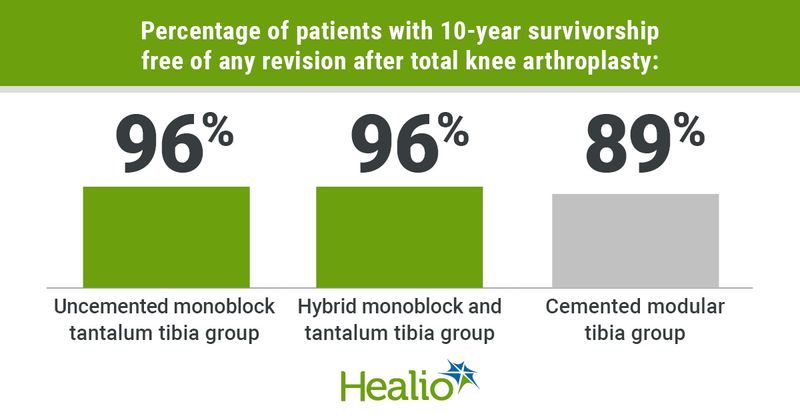Cementless monoblock tantalum tibia yielded excellent survivorship 10 years after TKA
GRAPEVINE, Texas — Results presented here showed use of cementless monoblock tantalum tibial components had excellent survivorship free from revision 10 years after total knee arthroplasty.
Between 2003 and 2006, Emmanuel Gibon, MD, PhD, and colleagues randomly assigned 389 patients undergoing a primary TKA to receive a cemented modular tibial baseplate (n=135), a hybrid monoblock and tantalum tibial baseplate (n=126) or an uncemented monoblock tantalum tibial baseplate (n=128). Researchers compared Knee Society scores, range of motion, radiographs and 10-year implant survivorship that was free of any revision and reoperation between the three groups.

“The 10-year survivorship free of any revision was excellent for the uncemented monoblock group and the hybrid monoblock group at 96% but lower, at 89%, for the cemented modular group,” Gibon said in his presentation at the American Association of Hip and Knee Surgeons Annual Meeting.

Tibial loosening, followed by femoral loosening and periprosthetic joint infection were the most common reasons for any revision, according to Gibon.
“The 10-year survivorship free of any reoperation was also excellent for the uncemented monoblock group at 92% as well as the hybrid monoblock group at 90% but lower, at 82%, for the cemented modular group,” Gibon said. “The most common reasons for any reoperation were stiffness, first, followed by wound issues and then, instability.”
Gibon noted patients in the cemented modular group had a 10-year risk for aseptic tibial loosening of 7% compared with 0% for patients in the hybrid monoblock and uncemented monoblock groups. He added patients in the cemented monoblock group had significantly more nonprogressive radiolucent lines both of the anterior posterior view and the lateral view, while patients in the hybrid and uncemented monoblock groups had significantly less radiolucent lines.
“Clinical outcomes were excellent and similar among all groups with regard to Knee Society pain scores [and] functional scores, as well as range of motion,” Gibon said.

